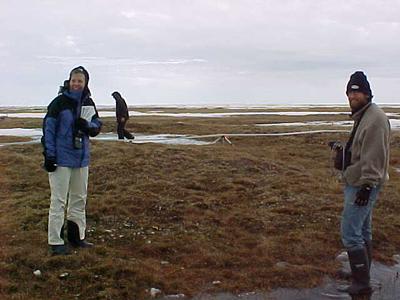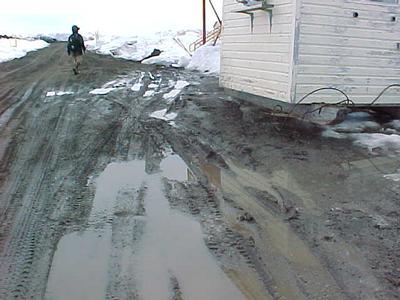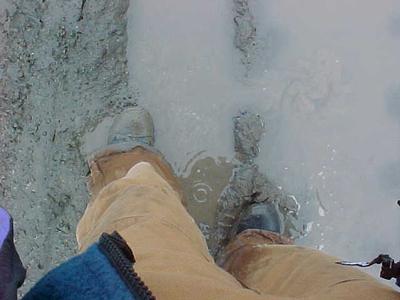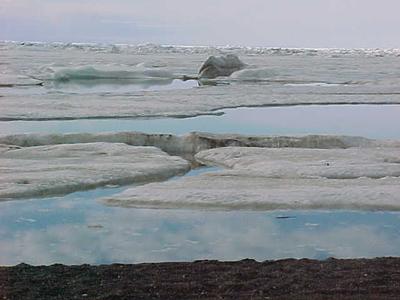13 June, 2001
Wednesday
A picture perfect day, blue sky, temperature in the 50s and no wind.
Life is settling into a daily routine. Up and breakfast at 7, out to the
site by 8:30, work till about 12 noon, back to the NARL lab for lunch then
back to the site till 3:30 or so, dinner at 5:30 and then lab work
(journals, email, transferring data, etc) till bed time, around 11pm. In
between those times one manages to get personal things like letters
written (postcards are my style!), reading done and other things one has
to do. Socializing is at dinner also when you are in the field you have to
keep a positive attitude going too and it is fun to just talk to the team
members.
We talk about the current project, the whys and wherefores of research
over the years; we also talk about other projects that are going on here
or other research, which tie in. Weve talked lots about science and how
its done and about the people and institutions that have made a difference
by providing funds supporting research and in most cases that is NSF. Then
there is always talk about everyday things. Yesterday I found myself
talking about my daughter and then my pets (2 dogs and 2 cats) and how
much I missed them! So its not all science talk.
The site is looking more and more like its ready to go. The arctic fox
that has been hanging around during the last week visited the site last
night and let us know she was there. She didnt chew anything up however.
Glen says the animals here will leave the wires alone as long as the food
supply is plentiful. When food becomes scarce thats when researchers have
trouble with the animals chewing wires. (all that vitamin PCV is a
necessary dietary supplement!)
All the teams are getting up and running this week. In a few days we will
coordinate running our first diurnal (24 hours measurements) with two
other research teams. One team, from Cal State LA and University of Md.,
are constructing a track adjacent to our site. They are measuring
reflectents (how much of the suns energy reaches earth and how much gets
bounced back into the atmosphere). They are looking at the effects
reflectents have on the physiological functions of the tundra plants. The
other team, from U of Michigan, is studying and mapping the plant
communities and putting together a vegetation map, among other things .
All three teams have worked up here previously and know each others work.
This year they will synchronize their diurnals, (data collection times)
and see if they can validate each others data plus provide a bigger
picture of what is happening in the tundra at different areas within the
same time period. An example of this would be if I wanted to learn more
about traffic patterns near my school. I could stand outside and monitor
the vehicles passing by from 7AM to 3PM. The next day I could monitor the
vehicles within a 4 squareblock area around the school and then I could do
the same for the roads leading into the area for the same time period.
However if I had many people doing this all on the same day I would get a
clearer picture and control for external variables, which might skew the
data. In this way more information could be collected and relationships on
how one event might affect another might become evident.
The advantages behind coordinating the diurnals are twofold; one is to
check each teams results against the others data and two, to provide a
larger spaceal look at what is happening in different areas of the
ecosystem under the same atmospheric conditions. Instead of getting a
snapshot of Glens 20 by 40 plot we will be getting a larger picture which
will include the wet area and the dry area of the coastal tundra along
with and the ridge area.
This is the first time the three teams will be trying this so it will be
interesting to see what comes of it. It is a more cooperative approach and
since all are interested in many of the same processes, namely CO2 flux,
it appears to be an efficient way to gather data.

Our neighbors in the field! Stan and Erica are working with a team who are presently constructing a rail line. (We requested a hig speed monorail from the parking lot to our site so we would not have to haul all our gear but no go!) They will be measuring reflectants along this transect line. More on this later.

When I say this place is muddy here is an example! This is the road into our site. Notice the yellow building on the right, it's on runners. Many of the building have these so they can be moved easily in the snow.

A picture on my boots, need I say more about their necessity!!

Members of the team studying sea ice out on the ice at 8pm. They are researching how sea ice forms and grows, reflective properties , temperature profiles and a number of other characteristics. Today was warm, 50degrees, and sunny and the ice is melting quickly!

The ice covered ocean as of this evening. A mote has formed along the shoreline which is making it difficult to get on the ice. There are meltways visible and the water is moving through the low areas quickly.

Glen (works for NOAA at the Climate Modeling Lab), Maggie and Spring under the whale bones outside Bower's resturant with the ocean in the background. You can get any type of food up here and so far it has all been delicious.
Contact the TEA in the field at
.
If you cannot connect through your browser, copy the
TEA's e-mail address in the "To:" line of
your favorite e-mail package.
|
